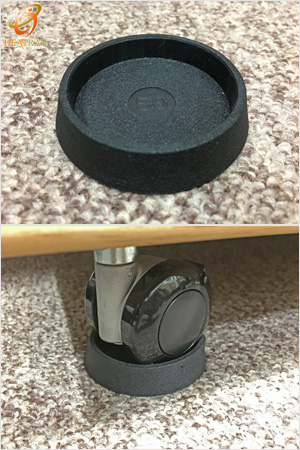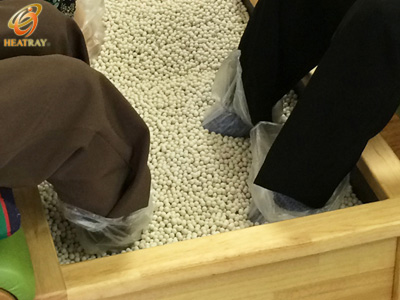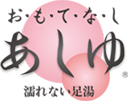FAQs for “OMOTENASHI ASHIYU,” a footbath that does not get wet.
Footbath method
| Q. | How many times a day should I take a foot bath? |
|---|---|
| A. | It is effective if you take a foot bath as many times as possible, separately from your bath. It is recommended to bathe at least three times a day in the morning, afternoon, and evening. |
| Q. | How long should I take a foot bath per time? |
|---|---|
| A. | Depends on person, but as a general rule of thumb, you should feel the benefits after about 10~20 minutes. |
| Q. | How far should I put my feet in? |
|---|---|
| A. | Please put your feet in up to your ankles. However, the bedrock stones at the bottom of the bath are extremely hot (60-70°C), so please be careful not to touch them directly with your feet (or hands). Please be careful not to touch them directly with your feet (or hands) as this may cause serious burns (including low-temperature burns). |
| Q. | Is there anything I should be careful about when taking a foot bath? |
|---|---|
| A. | Please check the temperature of the ceramic ball before use. Since everyone feels the temperature differently, for first-time users, start with a short time (about 10 minutes) on the upper surface of the ceramic ball with a lower temperature, and then gradually extend the time of the footbath by using an alarm, etc., just to be sure. ※The following persons should take special care and consult with a physician before using the bath.
|
| Q. | Is there a possibility of low-temperature burns? |
|---|---|
| A. | A. Low-temperature burns are burns that may occur when an object of 44℃ to 50℃ comes in contact with the skin for an extended period of time, and are especially likely to occur with hot water bottles and other warming devices whose temperature cannot be set. Duration of use is as follows
|
| Q. | Do I have to go in barefoot? |
|---|---|
| A. | No, you do not need to go barefoot since we do not use hot water. For hygienic reasons, we recommend that you wear socks. |
Effects
| Q. | What kind of effects can be obtained? |
|---|---|
| A. | Since it is not a medical device, we cannot frankly claim its effects, but a general thermal effect can be expected. We have also received the following comments from users at facilities where the system has actually been installed. 【Comments from users of the facility】
|
| Q. | Do you use it only during the cool or cold season? What is your reputation in the summer? |
|---|---|
| A. | The most popular seasons are fall, winter, and spring, and the main purpose of use is to “warm up. However, from what we have heard from customers and facilities that have introduced the system, it seems that many people use it in the summer as well for purposes such as “reducing swelling” and “relieving foot fatigue” after standing on the floor. It seems that many of our customers use our salon even in the summer to relieve swelling and tired feet after standing up. The baths are used and well-received throughout the year. |
| Q. | What are the effects of far-infrared radiation? |
|---|---|
| A. | You may often hear phrases such as “far-infrared rays are warm” or “far-infrared rays are good for you. However, it seems that not many people can give a clear answer when asked what far-infrared rays are. Therefore, we would like to explain it again. Light has different names and properties depending on its wavelength. Waves with longer wavelengths than the invisible red, which are outside the visible red wavelengths of visible light, are called infrared rays. Infrared rays are broadly divided into “near infrared rays” and “far infrared rays,” and electromagnetic waves of approximately 3 to 1000 μm are called “far infrared rays. Far-infrared radiation is emitted from all materials, and the higher the temperature of a material, the more strongly it radiates far-infrared radiation. Among the far-infrared ray bands, we use carefully selected natural ores (Onko Stone) that preferentially emit nurturing rays (8-14μm band), which are believed to have a positive effect on the human body. The light rays are in a wavelength band that easily resonates with the water in the cells of the human body, and the heat energy is carried by the blood, warming the entire body. The very limited wavelength range of 8 to 14 micrometers in far-infrared radiation is called “nurturing rays. Since these “nurturing rays” are the wavelengths that resonate most easily with water, heat energy is easily transmitted to the depths of plants and animals that contain a lot of water, and it is said to have the effect of promoting growth. Taking the human body as an example, the heat energy of far-infrared rays (nurturing rays) emitted from heated materials resonates with water molecules inside and outside the cells of the human body, is absorbed, and is efficiently transmitted to a wide area by the blood, resulting in “warming to the core and lasting (raising deep body temperature). This results in “warming to the core of the body and lasting warmth (increasing the deep body temperature). |
| Q. | What is the difference between footbaths that use hot water and general footbaths? |
|---|---|
| A. | Footbaths using hot water (not hot springs, etc.) mainly radiate heat from the outside to the surface of the skin. Therefore, it tends to take time for the skin to warm up deeply, and if you are satisfied with the rise in surface body temperature and leave before the deep body temperature rises, you may get a cold from the hot water. On the other hand, the warming method using bedrock stones that emit far-infrared radiation, such as “OMOTENASHI ASHIYU” has a wavelength band that easily resonates with water (especially in the 8 ~ 14 μm wavelength band of nurturing rays), which is also a property of far-infrared radiation, so that heat energy is absorbed by the water molecules (blood, etc.) in the human body through resonance, this is a characteristic of the system, which efficiently transmits heat energy deep into the human body. In other words, it is a method of heating that can be expected to “warm the core of the body and sustain it (raise the deep body temperature). |
Temperature Setting
| Q. | At what temperature should the temperature be set? |
|---|---|
| A. | It depends on the season, but we recommend that you set the temperature of the ceramic ball at around 42°C for comfortable use. Depending on the season and conditions, set the controller to “high” or “low” to adjust the temperature. Since the heat source is from the bedrock stone at the bottom, there is a temperature difference between the area near the bottom, the area in the middle, and the area on the top. Please enjoy the foot bath at the position (depth) where you feel comfortable warmth. Specifically, the temperature settings of the heater mounted under the bedrock stone are: low:60℃、high:70℃、heated:75~80℃. |
| Q. | How long does it take to get warm after turning on the power? |
|---|---|
| A. | It takes 2 to 3 hours. The ceramic ball should be stirred occasionally, as it is heated using the heat from the bedrock stones at the bottom. During winter and other times when temperatures drop, it may take up to 4 hours depending on the installation environment. The ON/OFF timer function is provided, so please change the setting time depending on the season. In addition, covering the top surface with a blanket or lap blanket made of heat-resistant material will help retain the heat and warm the unit more quickly. ※Please do not use the interval function or sleeve function. |
Installation
| Q. | Do I need a transformer for overseas? |
|---|---|
| A. | For one person AC100v/90w for Japanese specifications,
For use in Australia, a transformer and conversion plug (type) are required. A transformer and a conversion plug (type exchange) are separately required. (A transformer of 150W or more is desirable.) For more information, please contact us before purchasing. |
| Q. | Does installation require any special skills? |
|---|---|
| A. | No special skills are required. Simply place the ceramic balls in a wooden frame with bedrock on the bottom, turn on the power, and set the temperature. |
| Q. | Is it difficult to carry the unit when I want to change the installation location? |
|---|---|
| A. | The casters make it easy to move the unit. If it becomes necessary to lift the main unit, be sure to lift it by putting your hand on the bottom of the wooden frame (do not lift it by putting your hand on the top protrusion). |
| Q. | Can the casters be fixed to prevent them from moving? |
|---|---|
| A. | The casters themselves have a function to stop rotation, so please use that function. However, since the total weight of the single-seat type is only about 40 kg, the casters may move if you push hard on your feet during a footbath. In such a case, please purchase a caster support (50 mm in diameter is recommended) at a home improvement center.  |
| Q. | Does the power cord plug have any special specifications? And what is the length of the power cord? |
|---|---|
| A. | The power cord plug is 2-pole without a ground terminal (earth) and is the same as that of ordinary household electrical appliances. The length of the power cord (total length from the wooden frame to the power plug) is approx 280 cm. (From the bottom of the wooden frame to the controller is about 95 cm, from the controller to the plug is about 185 cm, and the width of the controller is about 9 cm.) |
Operational Aspects
| Q. | How long do the ceramic balls last? Is it difficult to clean? |
|---|---|
| A. | The ceramic ball can be used semi-permanently. In addition, daily cleaning is not particularly necessary. However, if the ceramic balls become dirty or dusty, please take them out of their wooden crates and remove the dust (once every few weeks). If you are concerned about stains on the ceramic balls (due to spilled beverages, etc.), please wash them in hot or cold water and dry them thoroughly before putting them back in the wooden crate. It is more efficient to wash them in small portions in a laundry net, etc. and dry them as they are. When washing, be careful not to drop the ceramic balls from a high place or otherwise subject them to shock, as they may break. |
| Q. | Is it safe to get infected with athlete’s foot (Bacillus thuringiensis)? |
|---|---|
| A. | We recommend that you enter the bath with socks on, and since it is a dry environment with no hot water, there is little concern about the growth of athlete’s foot-causing bacteria such as Bacillus thuringiensis. However, since it is impossible to assure that there is no infection, we recommend that you set up a rule to wear a plastic bag (e.g., 38 cm long x 25 cm wide sold at 100 yen stores, etc.) to prevent odor, especially when many unspecified people enter the room, such as at various facilities. We recommend that you set up an operational rule to wear a plastic bag to prevent odor. This reduces maintenance work by eliminating the need to clean ceramic balls without worrying about odor buildup.  |
| Q. | Do the ceramic balls have antibacterial effects? |
|---|---|
| A. | The ceramic balls in the “OMOTENASHI ASHIYU” come standard with “silver ion, antibacterial far-infrared ceramic balls” that achieve a high antibacterial effect (available April 10, 2019). However, it does not eliminate odors, so we recommend using it with a plastic bag attached as described in the previous section. |
| Q. | Can I spray the ceramic ball with deodorant spray? |
|---|---|
| A. | Please refrain from spraying deodorant spray. If the ceramic ball continues to be moistened with the solution, it may cause a malfunction. |
| Q. | How much does it cost for electricity? |
|---|---|
| A. | As a rough estimate, even if left on 24 hours a day, it will cost about 60 yen/day for one person, about 135 yen/day for three people, and about 200 yen/day for five people, in Japan. *Calculated as of March 2016. For example, the power consumption for 3-person use is 280W, so it would be easier to understand if you take it as the amount of electricity equivalent to about 3 100W reflector bulbs. |
| Q. | What are the running costs? |
|---|---|
| A. | The basic running cost after purchase is only the aforementioned electricity and plastic bags (to prevent odors from adhering to the ceramic balls). Please refer to each item for a rough estimate of the cost. |
| Q. | Is a lid for the top surface available? |
|---|---|
| A. | No, we do not provide a special lid, but we recommend the “Thermal Storage Quilt (half-bath size)” as an alternative. It is useful as a lap blanket during use of the “OMOTENASHI ASHIYU”. When not in use, the top surface can be covered to prevent dust accumulation and reduce power consumption. |
Troubleshooting
| Q. | Is there a warranty period? |
|---|---|
| A. | The warranty period for overseas use is not applicable, so there is no warranty. Initial defects upon arrival. We guarantee free replacement if the product is damaged during transportation. |
| Q. | What are the most common causes of malfunction? |
|---|---|
| A. | The most common cause is damage to the internal circuit board when the controller is dropped hard on a concrete floor or other hard surface.
Please be careful not to drop the controller. In addition, cable damage due to friction when the unit is moved while the power cable is touching the floor, cable damage due to caster entrapment during transportation, and damage to joints due to the cable being pulled strongly have also occurred in a few cases as causes.Please be aware of this. In addition, please note the following to prolong the life of the product.
|
| Q. | What should I do in case of breakdown? |
|---|---|
| A. | If the controller malfunctions overseas, replacement parts will be sent from Japan, and the customer (or distributor) will replace and repair it. |









